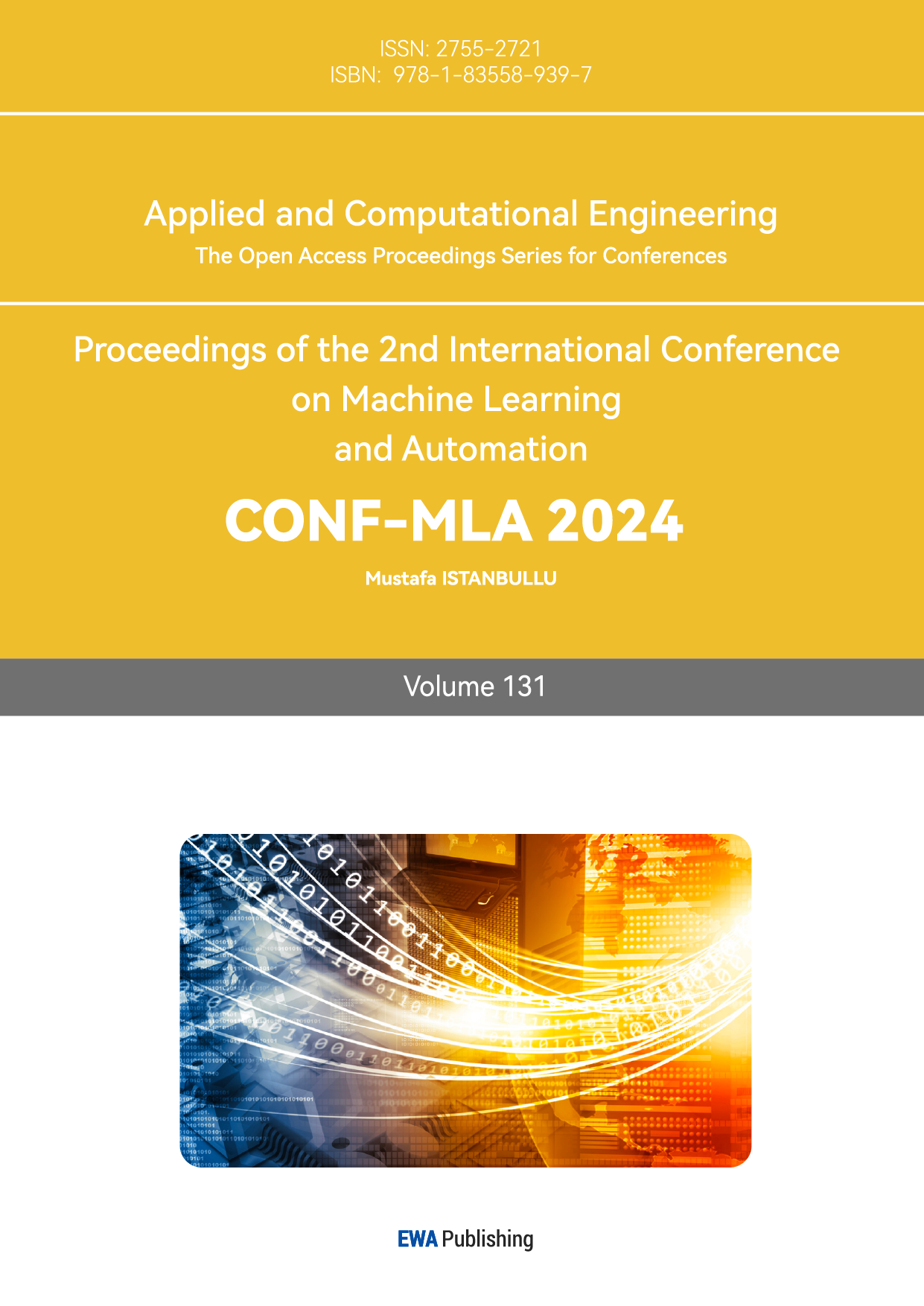1. Introduction
From January to July 2022, the number of international visitors was almost three times that of the same period in 2021 (+172%). International tourist arrivals in June and July 2022 are estimated to total 207 million, more than double the number in the same period last year. The total number of arrivals in June and July 2022 accounted for 44% of the first seven months of 2022 [1]. With the end of COVID-19, economies began to recover in each place, and people’s demand for travel is gradually rising. The unexpected number of visitors even brings operational challenges to tourism enterprises and facilities. In 2019, travel and tourism accounted for 10.4% of global GDP, or $10 trillion! In 2022, the sector's share of GDP will reach 7.6%.[2] Tourism makes a lot of contributions to the economy. also, in some places, tourism is the only source of finance.
According to the interview, we can find that the factors that hinder the enthusiasm of most people who want to travel are, first, making a suitable plan is a time-consuming and energy-consuming process; second, there is a lot of false advertisements and scam advertisements they cannot distinguish. So, this project aimed to solve these problems and help increase the efficiency of users during their preparation.
To do the research, we built a questionnaire survey for potential users. From investigation, we found that the most popular applications used by people to collect information and prepare for travel is Little Red Book, Ctrip and Gaode. However, there are various data on the internet, and each application only has a single function, so when people use it, they have to switch over interfaces, integrate information, check information, and pay for tickets. Take Ctrip as an example, customers' satisfaction with the website service is relatively high, but their satisfaction with the tour guide service and handling passenger complaints is relatively low. Secondly, it is also necessary to optimize the service at the tourism experience and exhibition level [3].
2. Methodology and Experiment
2.1. Overview
Before the official start of our project, we distributed our questionnaire to 32 test participants with female and male which is around 15 to 30 years old to gain real feedback. To ensure the security and privacy of the participants, we created an 11-question questionnaire on WeChat using a platform called Wen Juan Xing, and the content related to travel planning obtained the data collection of the considerations of the potential users.
2.2. Detailed designs
As shown in Table 1, through the questionnaire, we found that about 93% of people always have a travel plan, even if they do not plan themselves (partners do the plan), and only 10% of the people definitely do not use the travel guide. Also, the results show that the respondents' demand for software that can help them with generating AI travel plans reaches 80 high marks (out of 100), and the probability of using the software also displays 70 marks. Moreover, when asked if they think there is too much failed information in the software that has been used in the market today, most of the participants agree with that, and this result also gives us a deeper understanding of the users’ experiences and expectations.
After our deeper data analysis, we found that 78% of participants (25/32) hoped that this product would appear in the form of a pop-up window, which is inserted in the software, so this became our design direction. We learned the needs of people for the automatic generation of strategy software for multi-platform information integration.
With these authentic and valuable views from different people, our project could have a significant improvement and be built with a higher quality of operation.
Table 1. Statistic data of the survey
Q1: Will you make any plan by yourself? | |||||
Options | Subtotal | Ratio | |||
Do not have a plan | 3 | 9% | |||
I will create plan | 16 | 50% | |||
I will have a plan from others | 13 | 41% | |||
Fill in the total | 32 | ||||
Q3: Do you usually have a travel plan? | |||||
Options | Subtotal | Ratio | |||
Yes | 15 | 47% | |||
No | 2 | 6% | |||
I don't care | 15 | 47% | |||
Fill in the total | 32 | ||||
Q4: Which part will you consider when you making a plan? | |||||
Options | Subtotal | Ratio | |||
Hotel | 29 | 91% | |||
Transportation | 24 | 75% | |||
Special food | 26 | 81% | |||
Landmark | 24 | 75% | |||
Entertainment | 19 | 59% | |||
Others | 1 | 3% | |||
Fill in the total | 32 | ||||
Q7: Do you agree that there is too much false information in applications that you use? | |||||
Options | Subtotal | Ratio | |||
0~20 | 2 | 6% | |||
21~40 | 4 | 13% | |||
41~60 | 7 | 22% | |||
61~80 | 9 | 28% | |||
81~100 | 10 | 32% | |||
Fill in the total | 32 | ||||
Q8: Do you want to have a multi-platform information integration travel planning software? | |||||
Options | Subtotal | Ratio | |||
0~20 | 1 | 3% | |||
21~40 | 1 | 3% | |||
41~60 | 7 | 22% | |||
61~80 | 6 | 19% | |||
81~100 | 17 | 53% | |||
Fill in the total | 32 | ||||
2.3. Detailed experiments
Firstly, users need to enter some basic information such as the start place, destination, time and transportation, GPT will search all the travel information from all the websites it can find to create at least three travel plans for users, also, users can view the details (including the hotel, if the user is interested in with the result, they can put in a collection or pay for the hotel, ticket, etc. )
However, we also considered that sometimes users will not be 100 percent satisfied with the strategy from GPT, but it is really close. That is the reason we added the "edit" feature. As the user wants to change the flight or they found another hotel is better, just click "edit" to make partial changes to the plan, then the information can be saved and purchased directly.
As we know, this project is a plug-in inserted into other software, users' browsing records and purchase records will appear in the APP. As long as the user wants, you can check it in the collection on your personal home page or on the items you have purchased, and all flights ticket information will appear there. Users can view the flight details, and if there is any update message, users can receive it directly; at the same time, when the scenic spot needs to use the ticket, they can also straight open the QR code and scan into the scenic spot, which is more convenient for users to travel.
3. Test Results and Discussions
We have asked the three participants for suggestions to improve our project. This is just a prototype [4], so we can not guarantee that it is comprehensive. Our three participants have enough experience of traveling, so we believe that they will know more than us about some problems during traveling and that is why we really want to hear some constructive suggestions.
First, our participants think weather conditions need to be taken into account when GPT is making plans, the reason is it can avoid being unable to travel because of extreme weather such as tornados or rainstorms.[5] In addition, we want GPT to consider the weather conditions all the time but not only when sometimes users enter it in "add more condition"; for example, if the weather is too hot or cold, the possibility of not staying too long at outside should be as high as possible. All of our teammates strongly agree with this proposal, and we will try our best to improve that.
About the itinerary, participant 2 asked a question: "If people take the same route at the same time, whether it will cause blocking?". This is something that we can not ignore. Only focusing on the rationality of the route is not enough, and the visitor flow rate is also a part that needs to be considered. Our goal is to help users save time, and it is not just saving time for making plans but also saving time during traveling. In the future development, we will take into account the concept of off-peak travel. Nevertheless, we can also consult the advice of those who have taken the route and show it to users(Table 2). It is for users to better adjust their plans.
Expect suggestions for GPT’s work, one of our participants said “Maybe the user interface is too simple, I want it to be more attractive and colorful.” [6]. We decided to improve it by adding more related pictures and color matching in the future to make our user interface more lively and impressive.
Table 2. Statistic data of the user experience
Program design to consider comprehensively | There is no trouble in using it | Meets your expectations | |
User 1 | 8 | 8 | 7 |
User 2 | 7 | 8 | 7 |
User 3 | 9 | 10 | 9 |
4. UI Design
When we first started our user interface design, we were just imagining our product is a plugin in LittleRedBook. We don't want it to let users feel like this is an advertisement, so we added a "PLAN" button beside the "LIKE" button. We already considered that not every blog is related to traveling, so the "PLAN" button will only appear in some blogs which is about traveling. If users are interested in the city that appears in the article, they just need to click the "PLAN" button on the next page. This step is shown in Fig. 1. In this case, the user will go to the next page, and they will be asked to enter some basic information such as start point, destination, and date. One of our special designs is if the user isn't really sure the time for traveling, GPT will recommend some choices for them which can better help them to make the decision.
While GPT collect the basic information, it will search all the information that it could find and create some specific plan for user to choose which one is the best. Click the plan they like so they can view more details about the plan. Hotel, transportation, landmarks, and tickets are all able to be seen by the user. In addition, GPT will provide detailed price for user.
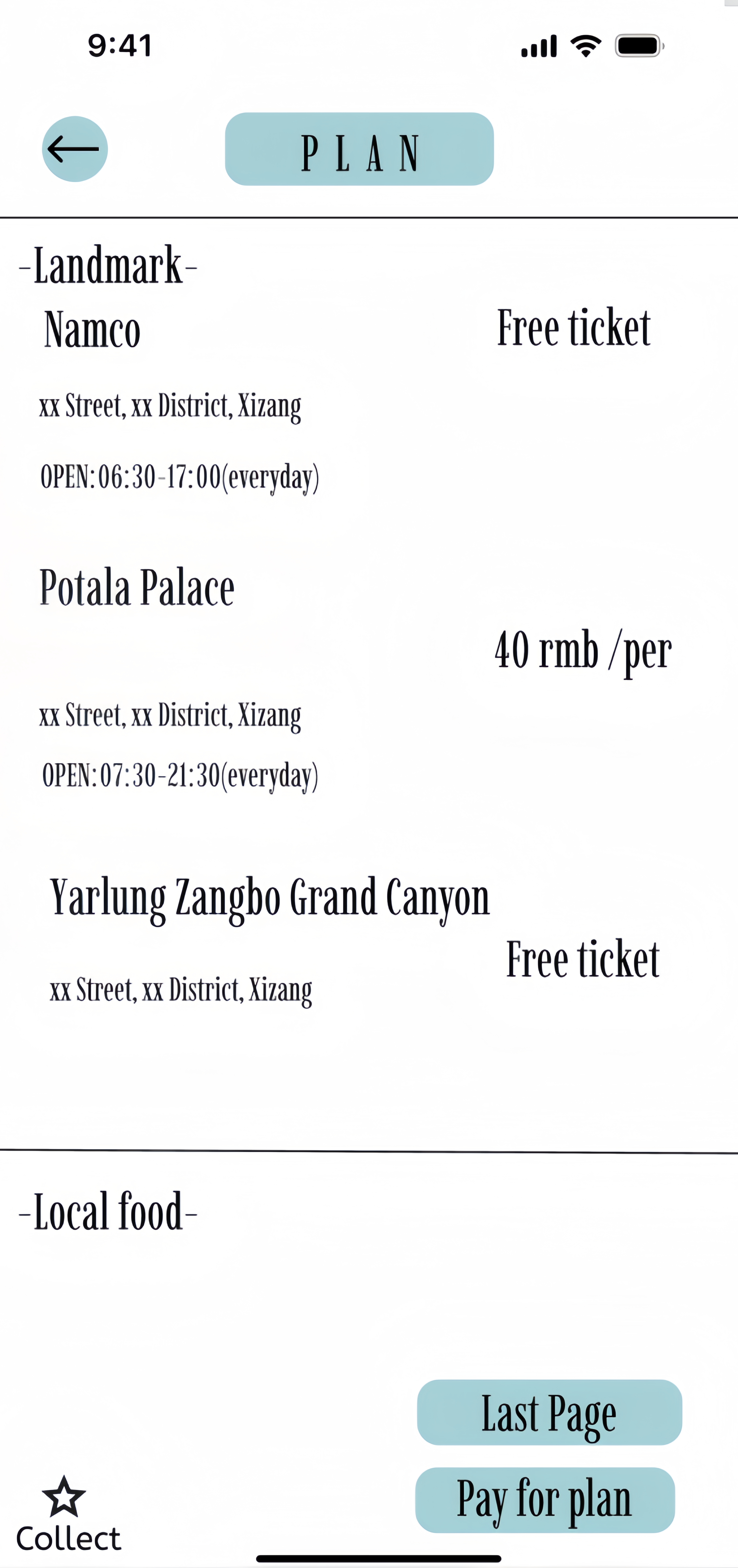
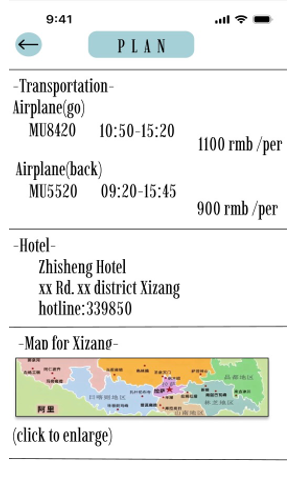
Figure 1. Detail of the plan
With an eye to some people who can't find the way correctly, GPT will also provide a map for them and it is something new compared to other software. Going to different websites or software to buy tickets and book rooms might also be inconvenient, so it becomes a main reason to add a "pay for plan" bottom. It can help user to book all the tickets directly.
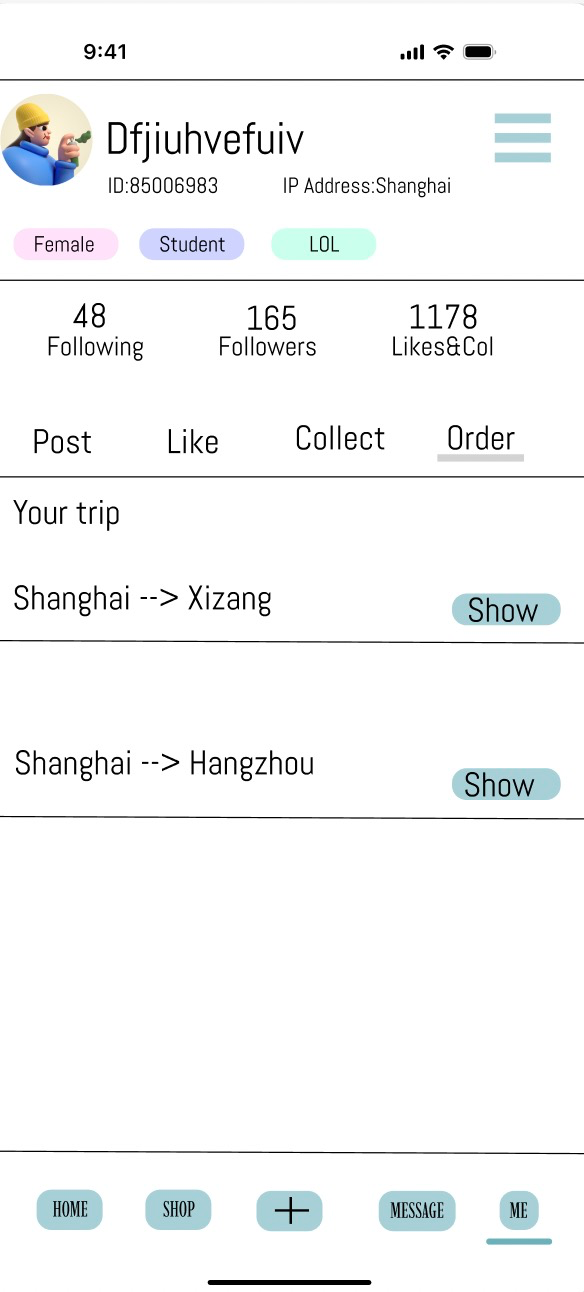

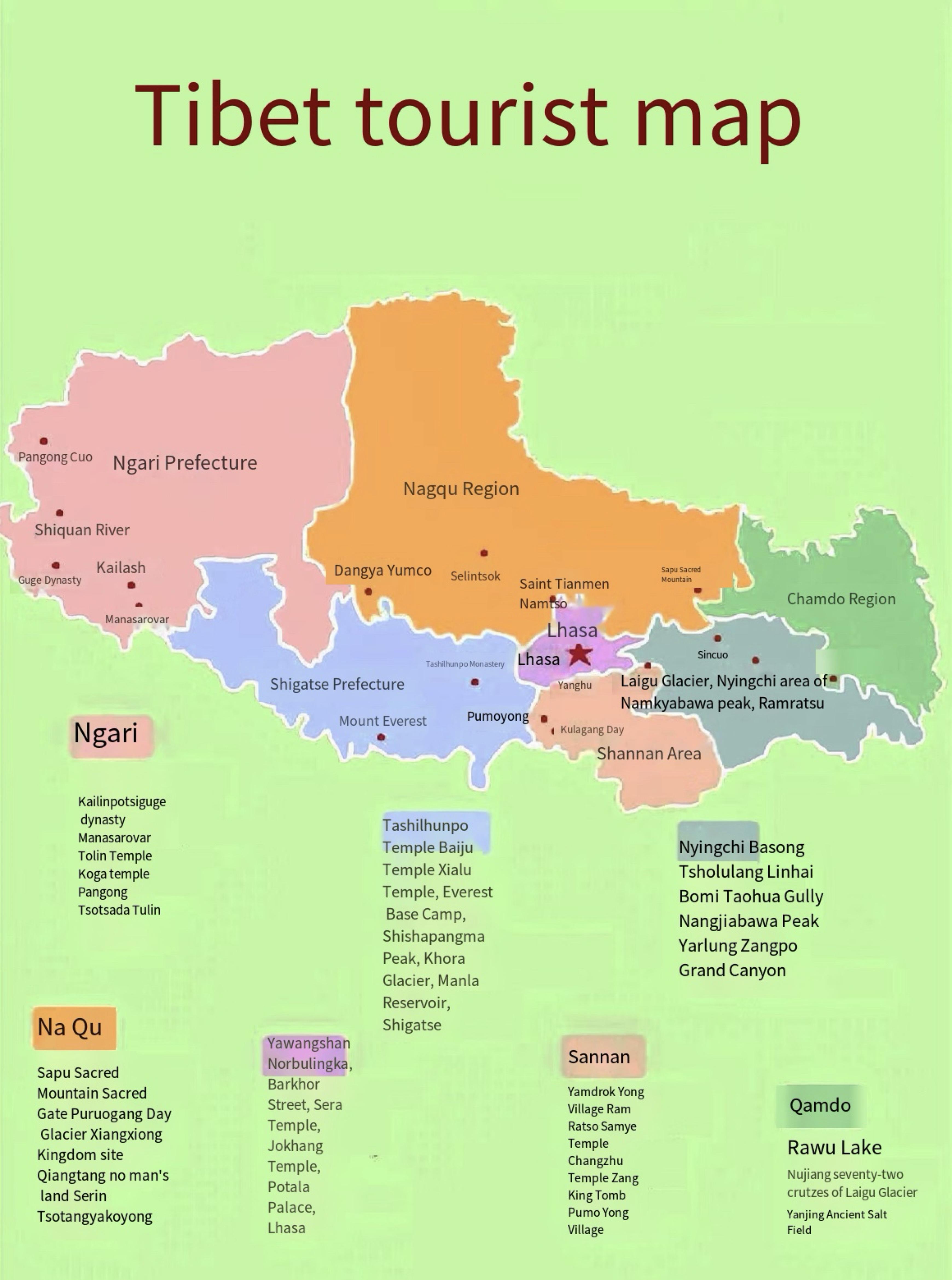
Figure 2. Personal page and payment&map
As we know, this project is a plug-in inserted into other software, users' browsing records and purchase records will appear in the APP. As long as the user wants, you can check it in the collection on your personal home page(see Fig. 2 for details) or on the items you have purchased, and all flights and ticket information will appear there. Users can view the flight details, and if there is any update message, users can receive it directly; at the same time, when the scenic spot needs to use the ticket, they can also straight open the QR code and scan into the scenic spot, which is more convenient for users to travel. This feature is going to be a great highlight of our project.
After learning about people’s need for auto-traveling information collection and arrangement software and some suggestions from them about improvement, we started our official design. Almost 80% of our participants think that we should add an additional box and an edit function; these will come true in our design.
5. Conclusion
In conclusion, the focus of our paper is the situation and current situation that people encounter when making travel plans, an applet designed to be a plug-in program that helps provide the simplest way of projecting the journey. The pursuit of this study is to save people's energy and time to make plans and avoid advertising interventions. The result represents that people tend to have this program; thereby, this design would continue to enhance user satisfaction by combining the functional merits of different programs to meet the goal of improving the convenience of making traveling plans by users.
References
[1]. "Current Trends in International Tourism," World Tourism Organization, Oct. 2022. [Online]. Available:https://webunwto.s3.eu-west-1.amazonaws.com/s3fs-public/2022-10/CE117_03_a_Current_trends_international_tourism_Ch_0.pdf?VersionId=jYKwgVK44JZbhEGO.Pp2SSmKShjMJKQ7. [Accessed: Sep. 2, 2024].
[2]. Mize, "The Economic Impact of Tourism: What You Need to Know," [Online]. Available: https://mize.tech/cn/blog/the-economic-impact-of-tourism-what-you-need-to-know/. [Accessed: Sep. 2, 2024].
[3]. T. Wuttipong, "Impact of Extreme Weather and Climate on Tourism," M.S. thesis, Dept. of Management, Chulalongkorn University, Bangkok, Thailand, 2021. [Online]. Available: https://ccgs-pim.in.th/download/mba/thesis/6271103090.pdf. [Accessed: Sep. 2, 2024].
[4]. "Definition of Prototype," [Online]. Available: https://www.example.com/prototype-definition. [Accessed: Sep. 2, 2024].
[5]. L. MA, Y. MA, J. SHU, G. SUN, and J. WANG, "A Study on the Influence of Extreme Weather and Climate on Tourism," [Online]. Available: https://www.example.com/study-influence-extreme-weather-tourism. [Accessed: Sep. 2, 2024].
[6]. "A Correlational Study Between User Interfaces Attributes to User Experience in a Website," IEEE, [Online]. Available: https://ieee.org/publications/correlational-study-user-interfaces. [Accessed: Sep. 2, 2024].
Cite this article
Xiang,G.;Huang,X.;Zhao,M. (2025). Interactive Automatic Travel Schedule Generation Based on Blog and GPT information. Applied and Computational Engineering,131,34-39.
Data availability
The datasets used and/or analyzed during the current study will be available from the authors upon reasonable request.
Disclaimer/Publisher's Note
The statements, opinions and data contained in all publications are solely those of the individual author(s) and contributor(s) and not of EWA Publishing and/or the editor(s). EWA Publishing and/or the editor(s) disclaim responsibility for any injury to people or property resulting from any ideas, methods, instructions or products referred to in the content.
About volume
Volume title: Proceedings of the 2nd International Conference on Machine Learning and Automation
© 2024 by the author(s). Licensee EWA Publishing, Oxford, UK. This article is an open access article distributed under the terms and
conditions of the Creative Commons Attribution (CC BY) license. Authors who
publish this series agree to the following terms:
1. Authors retain copyright and grant the series right of first publication with the work simultaneously licensed under a Creative Commons
Attribution License that allows others to share the work with an acknowledgment of the work's authorship and initial publication in this
series.
2. Authors are able to enter into separate, additional contractual arrangements for the non-exclusive distribution of the series's published
version of the work (e.g., post it to an institutional repository or publish it in a book), with an acknowledgment of its initial
publication in this series.
3. Authors are permitted and encouraged to post their work online (e.g., in institutional repositories or on their website) prior to and
during the submission process, as it can lead to productive exchanges, as well as earlier and greater citation of published work (See
Open access policy for details).
References
[1]. "Current Trends in International Tourism," World Tourism Organization, Oct. 2022. [Online]. Available:https://webunwto.s3.eu-west-1.amazonaws.com/s3fs-public/2022-10/CE117_03_a_Current_trends_international_tourism_Ch_0.pdf?VersionId=jYKwgVK44JZbhEGO.Pp2SSmKShjMJKQ7. [Accessed: Sep. 2, 2024].
[2]. Mize, "The Economic Impact of Tourism: What You Need to Know," [Online]. Available: https://mize.tech/cn/blog/the-economic-impact-of-tourism-what-you-need-to-know/. [Accessed: Sep. 2, 2024].
[3]. T. Wuttipong, "Impact of Extreme Weather and Climate on Tourism," M.S. thesis, Dept. of Management, Chulalongkorn University, Bangkok, Thailand, 2021. [Online]. Available: https://ccgs-pim.in.th/download/mba/thesis/6271103090.pdf. [Accessed: Sep. 2, 2024].
[4]. "Definition of Prototype," [Online]. Available: https://www.example.com/prototype-definition. [Accessed: Sep. 2, 2024].
[5]. L. MA, Y. MA, J. SHU, G. SUN, and J. WANG, "A Study on the Influence of Extreme Weather and Climate on Tourism," [Online]. Available: https://www.example.com/study-influence-extreme-weather-tourism. [Accessed: Sep. 2, 2024].
[6]. "A Correlational Study Between User Interfaces Attributes to User Experience in a Website," IEEE, [Online]. Available: https://ieee.org/publications/correlational-study-user-interfaces. [Accessed: Sep. 2, 2024].





